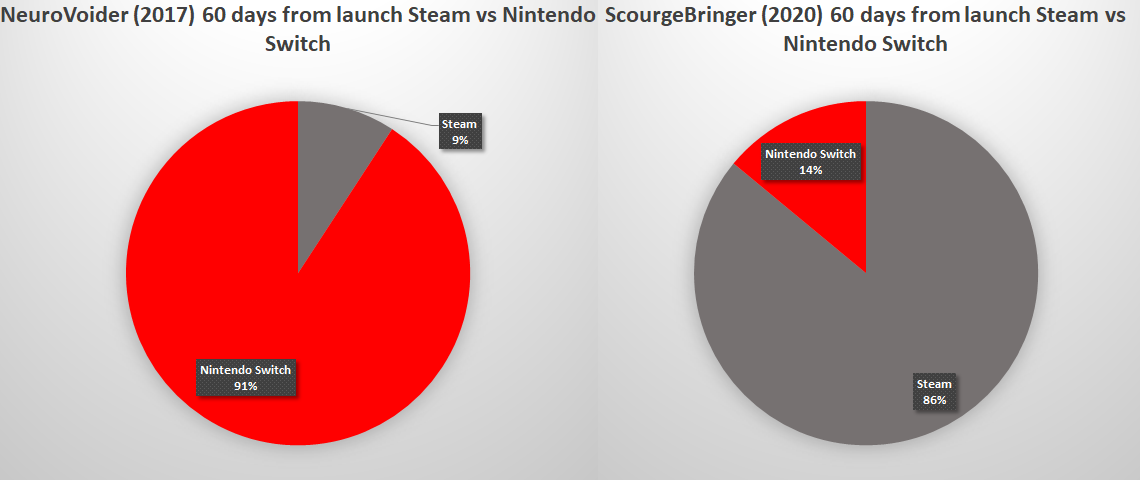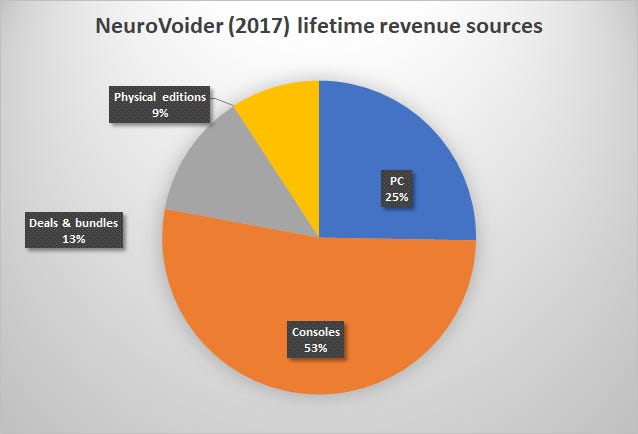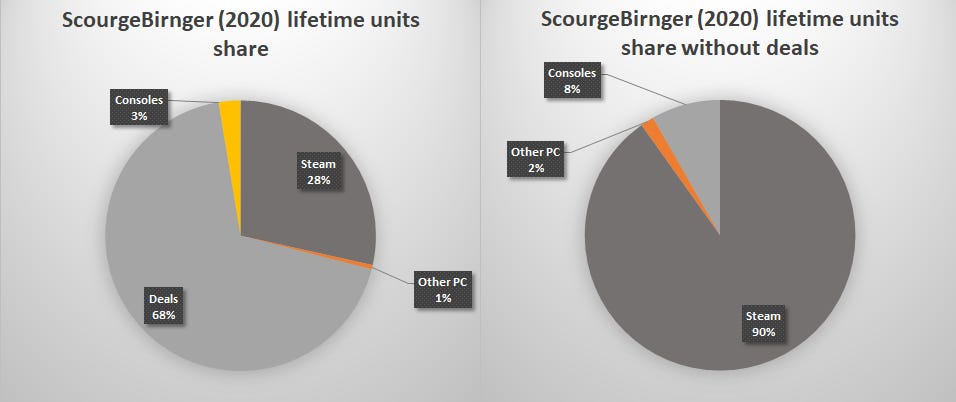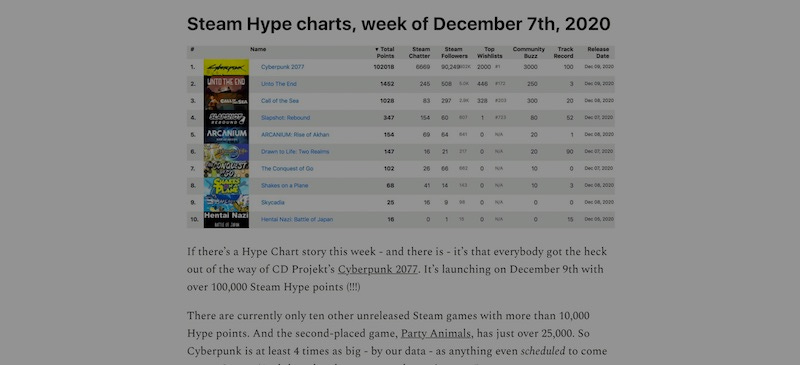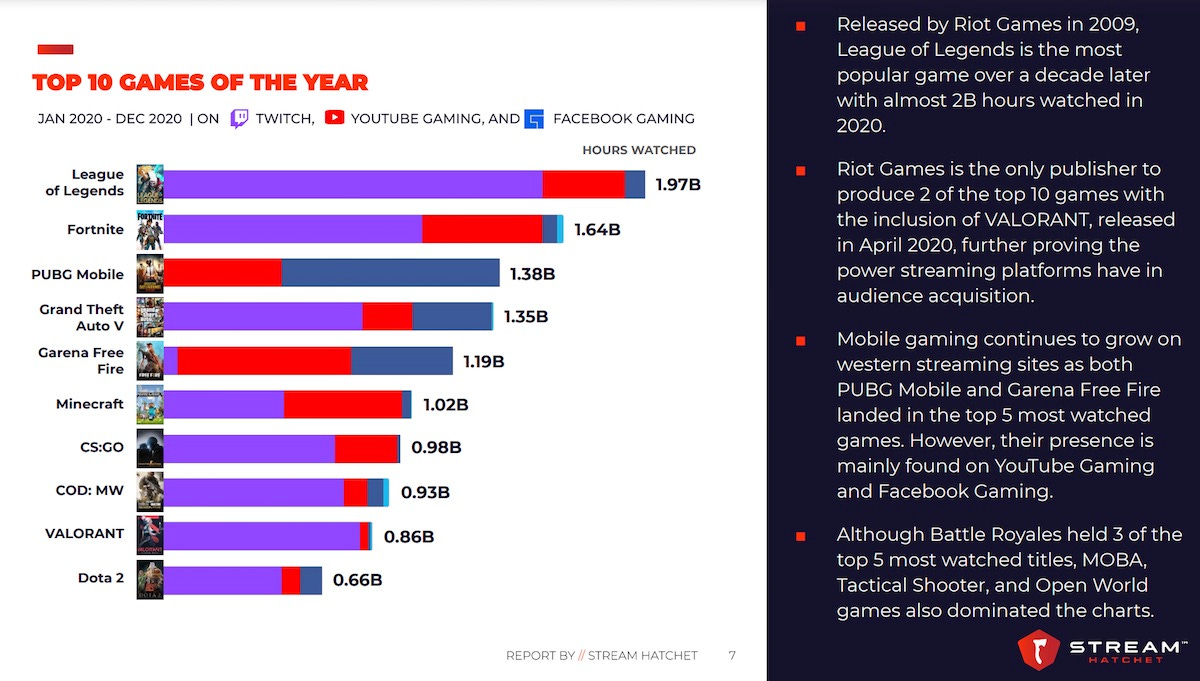Game platform deep-dive: from NeuroVoider to ScourgeBringer
Publikováno: 18.1.2021
Yep, platform make-ups have changed. A lot.
[The GameDiscoverCo game discovery newsletter is written by ‘how people find your game’ expert & GameDiscoverCo founder Simon Carless, and is a regular look at how people discover and buy video games in the 2020s.]
So, welcome back to the world of ‘staring obsessively at video game numbers and charts’ - which is why you dig us so much, right? (But seriously, we at GameDiscoverCo love transparency, a lot. Kudos to the game devs willing to put info out there.)
First up this week, we have a unique chance to compare a couple of games from different timeframes and the same dev, looking at their relative performance on multiple platforms…
NeuroVoider vs. ScourgeBringer - the data.
Over on Twitter, Flying Oak Games’ Thomas Altenburger was kind enough to launch a detailed thread on the relative performance of his two biggest recent Dear Villagers-published games, NeuroVoider (a twin-stick pixel shooter with roguelike elements, which launched in 2017) and ScourgeBringer (a 2D pixel sidescroller with roguelike elements, which debuted in 2020!)
He starts out with the most ‘shocking’ stat, see above. Though it’s perhaps not one that would surprise you if you’ve been listening to GameDiscoverCo’s comments that ‘Switch got pretty crowded, sales aren’t what they used to be just because of supply/demand disparities’.
As you can see, just comparing Steam and Switch, NeuroVoider - which launched early in the Switch’s lifecycle - had 91% of its revenue in the first 60 days on Switch - and 9% on Steam. But ScourgeBringer had just 14% of its 60-day revenue on Switch, and 86% on Steam.
Thomas adds some detail here: “NeuroVoider released very early in the [Switch] console lifecycle, and was pretty much alone [in the release schedule]. ScourgeBringer released during the most crowded month the console has ever known (while also performing super well on PC, vs. NeuroVoider’s bad PC launch).”
He also notes elsewhere on the extreme disparity: “ScourgeBringer did 4 times less [revenue] than NeuroVoider on Switch, while doing 10 times more on Steam.” FWIW, I think ScourgeBringer has a better ‘hook’ and is more enticing, so I get why it hit on Steam:
Next up, we have a wonderfully helpful chart duo - revenue sources for both games, including ‘deals’ (which he says includes ‘bundles [e.g. Humble], Prime Gaming, Game Pass, etc..’) It gives a good sense of the diversity of revenue you sometimes need to make things work.
Firstly, here’s NeuroVoider:
(He doesn’t name them, but it looks like Humble Monthly and Amazon/Twitch Prime were NeuroVoider’s main bundle revenue sources. And Limited Run did the physical edition of the game.)
Secondly, here’s ScourgeBringer - which has a PC/Xbox Game Pass deal, likely accounting for a fair amount of the ‘deals’ revenue slice on this graph:
But remember, we’ve heard that Game Pass is a single lump sum, unless renewed or fulfilling various other ‘performance bonus’ scenarios. Whereas the other revenue sources will keep trending up over time.
(Oh, and ‘Consoles’ means ‘individual game sales on consoles’, just to be clear. Some of the deals revenue also relates to console, just in a less attributable way.)
The final part of Thomas’ deconstruction is NeuroVoider’s lifetime unit share per platform, both including and not including bundles and physical editions. (Guessing its Humble Monthly/Prime Gaming appearances inflated its ‘bundle’ unit sales a lot!):
The similar data for Scourgebringer is a bit more abstracted, since it doesn’t show specific consoles. Remember that the console versions are very new, though - only having launched in October 2020:
As you can see, the charts show Steam being the vast majority of the individually sold units outside of ‘Deals’. But the subscription bundles/deals section is 68% of the total units to date. Not surprising, since ‘Steam and Game Pass’ is becoming a quite common mix for high quality non-3D AAA games like this.
What does it all mean?
Concluding: ScourgeBringer was a bit of a Steam hit that got slightly lost in the crowded Switch market, despite looking like it might do well on Switch, and getting a great NintendoLife review. And it got good penetration and revenue via its Game Pass deal.
(BTW, it still has time to make more Switch $ with discounts. It’s only been out for a couple of months there, so it’s early to evaluate lifetime results. This is why it’s so tricky to evaluate games side by side.)
On the other hand, NeuroVoider was in the right place at the right time in the Switch’s eShop lifecycle. Then it built up other useful revenue over time via a multitude of routes - bundles, physical, etc. Which you might hope ScourgeBringer would do too.
We’ll see if all of the same routes to success are still available, going forward. And thanks again to Thomas for providing all this info! (Bonus: here’s the players per country for these two games, per Thomas.)
GameDiscoverCo Plus - a sample newsletter!
So, some people have been asking - this GameDiscoverCo Plus paid subscription part of the newsletter which has all the extra info, what’s that really like, anyhow?
Welll, just for you, we’ve made the December 3rd, 2020 Plus-exclusive newsletter free for all, so you can see the kind of Steam game-analyzing shenanigans we get up to there. This was the week before Cyberpunk launched, so we were marveling about its amazing pre-launch interest.
But you can also see lots of analysis into smaller Steam games, both pre and post-launch. And since we published this Plus newsletter, we’ve started to look into other console/PC game platforms too, like Switch, Apple Arcade and Epic Games Store.
(You also get access to our subscriber-exclusive Discord and the actual Steam Hype back end, so you can look up games to your heart’s content. I actually go to the Steam Hype back end instead of Steam itself, if I want to try to work out pre-launch interest on a game nowadays. The data is.. working?)
Anyhow, that’s the hardest sell we’re going to attempt. So feel free to sign up if you’d like to support us:
The game discovery news round-up..
Since mid-last week, an irritatingly large amount of game platform and discovery news has built up (lol). So, we’ll leave some to the second newsletter of the week in a couple of days. But let’s see what amazing info has turned up since we last chatted:
Sad to learn that Ryan Clark (Industries Of Titan/Crypt Of The Necrodancer) has recorded his last Clark Tank, basically ‘the video version of this newsletter’, analysis wise. The final stream is now up on YouTube, and it’s 1 hour 40 minutes of goodness, even in edited form. Lots of great thoughts in there, and even a fascinating retrospective on his 2015 ‘5 Myths Of The Indiepocalypse’ article. Though he’s stopping Clark Tank, Ryan is still around, of course, and he’ll still be doing YouTube goodness like his hook videos.
Google Stadia has announced its latest major feature, and it’s kinda a neat one: “We're excited to announce that State Share, the newest Stadia Enhanced Feature, is launching on January 20th. Capture a playable slice of a game & share it instantly with friends to try for themselves.” Looks like the Hitman trilogy is the first to roll this out. It definitely deconstructs a game - since it’s like being able to skip anywhere in a movie instantly. But there are plenty of games it makes sense for, and it’s another attempt to make Stadia’s success ‘only possible on cloud’-centric.
Haven’t seen much coverage of this, but Gaming On Linux notes that: “In a move that might help boost Linux gaming numbers, it seems Google are still moving forward with their plan to get Steam running properly native on Chrome OS during 2021.” And there are more powerful Chromebooks coming. So that might be a cool incremental source of players for Steam?
The excellent folks at Stream Hatchet have released their 2020 year in review (PDF link), and there’s plenty of interesting info in there. From the ‘top games’ slide, above: “Released by Riot Games in 2009, League of Legends is the most popular game over a decade later, with almost 2 [billion] hours watched in 2020… Riot Games is the only publisher to produce 2 of the top 10 games with the inclusion of Valorant.”
NPD’s Mat Piscatella has a big thread on U.S. physical/digital-ish console sales in December 2020, and notable: “Nintendo Switch was the best-selling hardware platform in units and dollars for both December and the 2020 year. Annual dollar sales of Switch hardware were the 2nd highest for a platform in U.S. history. Only the 2008 dollar sales of Nintendo Wii were higher.” Looots more in there, including a yearly Top 20 headed by two Call Of Duty titles.
I link mobile game dev analysis crew Deconstructor Of Fun from time to time, and its 2021 predictions are now debuting. Vital reading if you want to understand the mobile F2P market - there’s an article on the state of puzzle games, and another on what’s going on in the hypercasual market - more ASMR games than I expected, for starters!
Microlinks: The MIX folks are doing a Game Dev Direct indie streaming showcase in March, I presume timed to when GDC was intended to be; are big game publishers retreating to the safety of licensed games again?; wacky physics robot battler Clone Drone In The Danger Zone is doing great on TikTok with an official account.
[We’re GameDiscoverCo, a new agency based around one simple issue: how do players find, buy and enjoy your premium PC or console game? You can subscribe to GameDiscoverCo Plus to get access to exclusive newsletters, interactive daily rankings of every unreleased Steam game, and lots more besides.]
